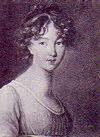
This bookmark, knit in Pattern Number 36 (c. 1830's) from Susanna E. Lewis's Knitting Lace, was a perfect project for experimenting with DMC's linen embroidery floss. I used three skeins on 3mm needles.
Reproduction and historic knitting inspired by original garments, objects and patterns from the past.



Here are two kinds of knitted undersleeves (literally, worn under indoor clothing) from the mid-ish 19th century. Both are knitted flat or back and forth, and then sewn up.
The first photograph shows one set still in progress on HISTORICALLY INACCURATE NEEDLES but the only ones from my vast collection that gave me the correct gauge/tension. This pair, the very full sleeve ones, were improvised from the daguerreotype below, with the upper arm ribbing and bands from tighter fitting patterns I have seen and making the lower puff very large so as to show under the wide, open sleeves of the top garment or dress. This set was knit from the wrist up. The wool is Brown Sheep Nature Spun Worsted (Scarlet (2 skeins) and Silver Sage 1 skein) on 4.0/6US needles with a gauge/tension of 6.50 stitches/inch in the full part of the sleeve and 6 stitches/inch in the ribbing. The same size needles were used throughout.
The second, closer-fitting pair are from an original pattern ( Knitted Under-Sleeve by Mrs. Jane Weaver in Peterson’s Magazine, January, 1859, Volume XXXV, No. 1) which called for two sizes of needles (“1 pair steel knitting needles, common size, 1 pair bone knitting needles, small”) I had to use the larger sized needles throughout but still did not, however, achieve the puffs as shown in the original illustration, especially when wearing them (see below.) This set was knit from the upper arm down to the wrist as directed in the pattern. Brown (for the puffs) and crimson (ribbing) “single zephyr” wool was suggested in the original pattern. The wool for this pair is Morehouse Farm Merino Lace (Midnight (2 skeins) and Natural White (2 skeins) on 2.75/2US needles with a gauge of 9 stitches/inch on the puff parts and 10 stitches/inch in the ribbed parts.





Viennese Domestic Garden (1828-30), Erasmus Ritter von Engert (Austrian, 1796-1871)
Oil on canvas, 32 x 25 cm.
Nationalgalerie, Berlin
I love this painting for its light, cool summer garden and, of course, the quasi-invisible knitter tucked away in the lower left corner, working on what looks like a stocking. The overall effect is elegant as is the woman's cap and grey gown. I also like the fact that she is knitting and reading at the same time, something I enjoy doing whenever the knitting is easy enough to just follow with my fingers.